Table of contents
- Concept comparison: Honda Fireblade, KTM 990 Super Duke R, Suzuki GSX-R 600, Yamaha FZ6 Greed for achievement
- Greed for achievement
- Pressure to perform
- Feelings of elation
- An up and down
- Conclusion + evaluation
- Technical specifications
- PS measurements
- Speed wheelies
- Measuring and firing – this is how the test went
- What really presses
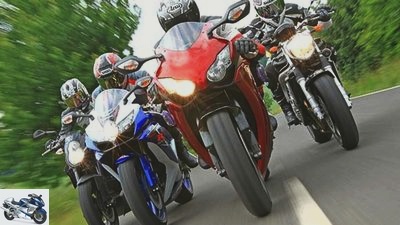
Gargolov
motorcycles
Concept comparison: Honda Fireblade, KTM 990 Super Duke R, Suzuki GSX-R 600, Yamaha FZ6
Concept comparison: Honda Fireblade, KTM 990 Super Duke R, Suzuki GSX-R 600, Yamaha FZ6
Greed for achievement
Content of
Engines whine, the test bench roller glows, the data recording smokes, tires whimper, testers groan. PS pushed people and material to the limit in order to answer an elementary question: How much power does the inclined sports driver need on the country road?
Jorg Schuller, Volkmar Jacob
08/20/2008
Greed for achievement
Shit, the handlebars can hardly be moved. The electronically controlled damper of the Fireblade tightens the steering with increasing speed. What fights the kickback when gasping, hinders proper wheelies? the bike is difficult to balance in the unicycle dance. So: pinch your cheeks and keep the blade on course by shifting your weight, always keeping an eye on the speedometer. What for? First, because it’s fun, and second, as part of a special test in which PS determines, among other things, how much power a 200 km / h wheelie calls up. Second, third, fourth gear; Speedometer 180, 190, 200 ?? yeah, made it, at 212 km / h the front wheel smokes and squeaks on the floor. The evaluation of the data recording shows throttle positions and speeds. PS compares this data with various test bench runs and can thus determine the required power and the required torque. How much punch does the Blade need for a high-speed wheelie? Continuing with the core question of this story: What kind of power do sporty drivers use on country roads? Hardly the roughly 180 hp of a feather-light super sports car, of course. But how much power, how much torque is it actually? PS equipped four different bikes with data recording and chased them over a blocked mountain stretch with typical country road characteristics.
Get into the ring: the new, unrestricted queen of the mass production superbikes, Honda’s Fireblade. Strong, light, fast. More performance than with it is unlikely, it forms the reference. The also brand new Suzuki GSX-R 600 represents the sporty six hundred class. As a representative of the bare guild and the only two-cylinder in the test field, the newly revised one mixes KTM 990 Super Duke R. with. Last, but not least, a lower mid-range bike: the Yamaha FZ6. What can the cheap nude in the 98 hp version do against the seemingly overwhelming competition? First of all, the Honda Fireblade shows what it’s made of. Determined to iron the others, she storms towards the first corner, a 45 km / h left. Fully anchor, bend. First surprise: Despite its relatively slim 200 kilos, it bends a little more slowly than the competition. This is particularly due to the 190 slippers? the competitors roll on more handling-friendly 180s in the back.
Pressure to perform
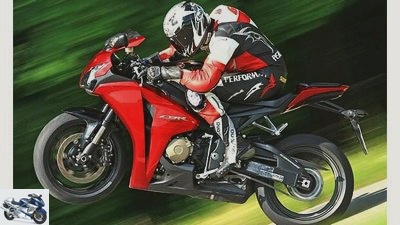
Gargolov
Power in abundance, light as a feather, pure sports suspension and top brakes – almost impossible to crack the blade.
So use a little more muscle and go around the corner. The next abnormality while working out? between 3000 rpm and 4500 rpm the Fireblade drive takes a noticeable pause, only then does it continue with unchecked smoke. In first gear, there are a little over 60 km / h. From then on, the Honda storms up the mountain so brutally that the steepest part of the route (16% gradient, between point 1 and 2) feels like East Frisian flat land. Only the increasing tendency to wheelie indicates that the Honda is racing uphill. For maximum propulsion, the pilot shifts his weight forward, shifts into second gear early and surfs the gigantic torque wave. Most of the tractive effort of the entire test track acts on the approximately 170-meter-long straight. As a maximum value, a huge 3260 Newtons pull the blade upwards. The throttle flaps are fully on the stop for about a second and call up 130 of their maximum 162 rear-wheel horsepower (at 12000 rpm) at 8700 rpm. At the same time, there is 110 Nm on the clutch, which means around 850 Nm on the rear wheel in second gear.
After the first, narrow passage, the terrain becomes more open and the arches wider. In the right-hand bend, the GPS determined almost 91 km / h, through the long left-hand bend just before the end of the test track, the Honda shoots at almost 148 km / h. Around 140 HP and 720 Nm on the rear wheel tear (3rd gear, corresponds to 110 Nm on the crankshaft). The superbike covers the 900-meter route in 36.8 seconds. Will the competition bite their teeth into this brand? As the first competitor, the Suzuki GSX-R 600 takes up the challenge. Since the German importer PS could not provide a test motorcycle, the Speer company in the Swabian town of Reutlingen kindly lent us their demonstration machine. Special thanks go to the guys from 2D: The data recording professionals were always at our side with help and advice when we were looking for the right signals in the jumble of electronics on the four bikes and during the subsequent evaluation of the measured values. Back to the test.
The newly renovated engine of the GSX-R 600 develops 114 hp at 13300 rpm and generates 65 Nm at 11200 rpm on the crankshaft. Of this, 106 hp and, extrapolated to second gear, 649 Nm arrive at the rear wheel. Compared to the Honda, a clear gap, but the Fireblade could only partially deliver its full punch. So does the 600 have a chance? On the steep section, the Gixxer cheers with a deafening 11,900 rpm and delivers almost all of its power to the rear wheel with 102 hp, with the previously applied maximum torque it does that anyway. This network accelerates the GSX-R on the short stretch to 124.3 km / h (Honda: 128 km / h). The Suzi is also fast on the following curve combinations up to the end of the first section. In section I (length: 475 meters) you are missing only 0.3 seconds on the blade. Their excellent driving characteristics play a large part in this. The little Suzuki sticks into the corners with millimeter precision and handy on the Metzeler rubbers, can be perfectly directed at any time ?? top notch.
Feelings of elation
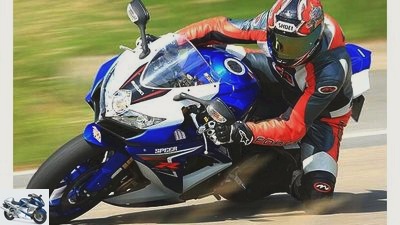
Gargolov
Suzuki GSX-R 600: nimble precision tool and excellent mood-maker in winding hunting grounds.
On the second part of the test track, the GSX-R, which also weighs 200 kilograms, loses a little more time on the Honda. Although it drives slightly faster through the right-hand bend at point 3 at 93 km / h, and when you then accelerate with the shower fully open, it again calls up almost the entire potential of its drive. The Suzuki’s GPS attests to a top speed of 138 km / h, which is almost 10 km / h less than the Honda had there. In the end, the gap adds up to 0.8 seconds. So much for the super athletes; the KTM 990 Super Duke R crashes onto the slopes. With a fat V2 punch from the cellar, it should easily sniff the Fireblade out of the hairpin bends, according to the widespread opinion. A misconception that stems from the fact that two-cylinders with the same displacement generate their torque at lower speeds than four-cylinders. Using the example of Super Duke R versus Fireblade, it looks like this: Between 2500 rpm and 5000 rpm, the KTM produces up to 17 Nm or around 26% more torque on the crankshaft than the Honda. Sure, the break in the blade in this area increases the difference drastically.
But even without this weak phase, the curve of the Honda ran up to 5000 rpm below that of the Austrian. With a similar gear ratio and at the same, low engine speeds, two-cylinder engines actually have more power out of the corners than four-cylinders. If the four-cylinder driver downshifts, things look different. The Honda generates a much fuller torque curve than the Super Duke R. This means that its usable speed range is wider than that of the KTM. At full throttle, press at least 100 Nm on the crankshaft between 6800 rpm and 12000 rpm, the peak value is 111 Nm. The Mattighofenerin only produces 100 Nm between 7600 rpm and 8600 rpm, a maximum of 104 Nm. So that no misunderstandings arise: PS loves two-cylinder! The testers particularly liked the 990 versions from KTM: The engines run smoothly, super-elastic and are greedy and powerful. It is a question of faith whether one prefers two-cylinder with a strong character to the four-cylinder power propulsion system. Especially since the Super Duke in Sector I sprints over the line at the same speed as the Honda? after 20.6 seconds. Only in Sector II does it leave a relatively long time; in the end she is 1.3 seconds short of the Fireblade. The fact that it even crosses the finish line 0.5 seconds behind the GSX-R 600 is not due to a lack of power: With 109 HP on the rear wheel (maximum: 124 HP), it has significantly more power than the Gixxer, thundering as proof of this claim despite 3 kilos more weight and without slippery full fairing about 2 km / h faster through the fastest passage than the Suzi.
The KTM struggles with the hard basic set-up of its suspension elements. Front and rear rumble roughly over the smallest bumps, trust in the chassis may not arise. So it’s hardly surprising that cornering speeds on the KTM are usually the lowest. Always focused on uncompromising sport, the Austrians went a bit over the top when developing the 2008 Super Duke R. The chassis is too tight and insensitive for the country road. On to the outsider, the Yamaha FZ6. It represents the popular, inexpensive 600 nakeds. How close does a middle grader get to the performance of top bikes? In this test it competes in the open, 98 hp version. According to the test bench, it develops 92 hp on the crankshaft at 12,000 rpm, 83 of which arrive at the rear wheel. The Yamaha uses this, which is surprising, as well as its maximum torque (577 Nm on the rear wheel in second gear) on the incline completely. Similar to the Suzuki, it yodels its soul out of the engine block, screams and screeches heartbreakingly. At the fastest point of the steep section, the Yam creates 120.2 km / h, almost 8 km / h less than the Blade ?? a lot on this short piece. Nevertheless, at the end of Section I, she only lost 0.5 seconds on the Honda and KTM, only 0.2 seconds on the GSX-R 600. The FZ6 takes slow corners usually faster than the competition.
An up and down
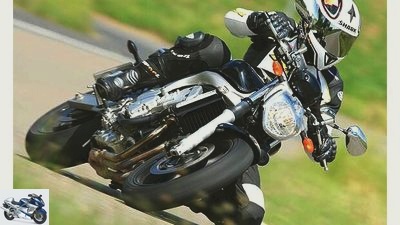
Gargolov
Penny foxes noted: Yamaha FZ6 – gas comfortably and save. Curving fun has seldom been so cheap.
Here, the 212 kilo Yamaha can only hold a candle to the GSX-R. In Section II, however, the FZ6 loses 2.1 seconds on the fastest time; she hisses too “only” 133.5 km / h through the fast left curve. In total, the little Yamaha loses 2.6 seconds or, in other words, it still drives a good 59 meters behind the Fireblade when it rolls through the finish line. So far, all bikes have only sprinted up the test track (average gradient: 7.5%). Logically, this requires more strength than going downhill. Are the time differences in the opposite direction less? Yes: In 36.4 seconds the Honda shoots downhill at the same time as the KTM. As the ?? Hasn’t anything changed on the chassis? But downhill, the wheel load distribution, center of gravity and geometry change, which obviously has a positive effect on the KTM’s handling. With 36.5 seconds the GSX-R only loses a tenth of a second; 38.4 seconds pass with the FZ6. The time is particularly due to its very soft fork: it has too few reserves ready for downhill braking attacks.
At first glance, the time differences between the test subjects on the test-relevant uphill climb appear rather small. If you extrapolate the differences over a 5-kilometer route, the differences are clearer. Then the second fastest, the GSX-R 600, loses just under 4.5 seconds or over 105 meters. The values of the FZ6 are even more serious: almost 14.5 seconds or about 330 meters are missing on the blade. This plays a subordinate role for country road riding, but it clearly shows that powerful bikes can play out some of their greater potential even on winding country roads. Theoretically. Because then you are already far in illegality. And the pilot must be able to implement the punch. But this is another story.
Conclusion + evaluation
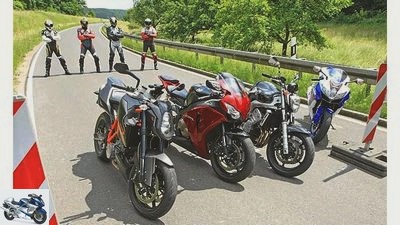
Gargolov
Unfortunately, bouncer Hakan had no time, so the testers took over the job themselves …
On the test track, PS called a maximum of 140 ponies on the rear wheel (Fireblade); makes 148 hp on the crankshaft. That is more than expected, but then there are already driving license-destroying 150 km / h. When the driver squeezes the Suzuki GSX-R 600, he stays on the blade surprisingly well. He only has to let the Honda go at speeds beyond good and bad, and the frantic screeching of a 600 is definitely not for everyone. The KTM Super Duke R was a bit disappointing. Although her engine is a pearl, the ultra-hard chassis thwarts the Austrian woman. And the Yamaha FZ6? The cheap bike follows behind, but does very respectably up to a certain speed.
| PS rating |
Technical specifications
| Technical specifications |
PS measurements
With the same throttle position, the Honda Fireblady clearly surpasses its competitors. Funny: The Yamaha FZ6 squeezes out 83 rear-wheel horsepower at full throttle, for so much power the throttle valves of the Honda Fireblade are only opened by 32 percent. And to produce the 124 rear-wheel horsepower of the second most powerful bike (KTM 990 Super Duke R), the Honda only needs a little more than half-throttle. Despite the same displacement, the Suzuki produces
GSX-R 600 has significantly more power and torque than the Yamaha FZ6. The torque of the FZ6 briefly surpasses that of the Gixxer only when the throttle hand is used little. At 50 percent throttle position, the four-cylinder already give up to 75% (Honda) of their power. In contrast to the curve of the KTM, those of the Japanese run degressively the further the throttle valves are opened. When they are 80% open, they already call up around 95% of their maximum output. So if someone claims to be driving a passage, couldn’t it? as so often? It is a felt, but an actual full load. PS calculated the maximum torque on the crankshaft on every bike
the 2nd gear. More than 850 Newton meters pull the rear wheel of the Honda Fireblade at full throttle? there is something going on.
Speed wheelies
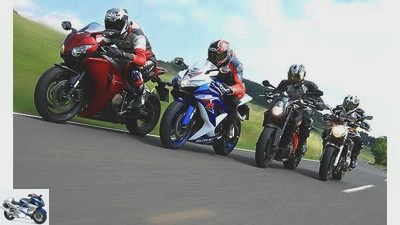
Gargolov
They are all powerful. But how much power is a speed wheelie?
What power does a speed wheelie need? Depending on: the closer the rider holds the bike to the tipping point, the less power the dance demands. This works differently with different bikes. With increasing speed, more power is required due to the driving resistance. With a 212 km / h wheelie, the Fireblade peaked at 142 rear wheel horsepower and its maximum torque of 111 Nm (crankshaft). The GSX-R used 104 hp on the rear wheel for a 198 km / h wheelie, the Super Duke 63 hp at 160 km / h. Distances: Super Duke 494 meters, Fireblade 542 meters, GSX-R 600 599 meters. ask?
Measuring and firing – this is how the test went
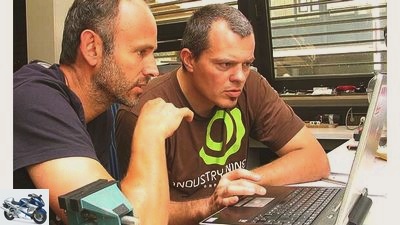
Gargolov
International authority: When data guru Dirk Debus from 2D (left) gives tips, the testers prick up their ears.
PS equipped all bikes with data recording. Rotational speeds and throttle valve positions allow conclusions to be drawn about how much power and torque the rider used on which bike. A GPS transmitter recorded the speed and located the bikes. The Suzuki GSX-R 600 and the KTM 990 Super Duke R send their gasoline / air mixture through a double throttle system as standard. This means that the driver only operates the first throttle valve with the throttle grip. The on-board computer commands a servomotor for the second throttle valve, taking various parameters into account. Interesting to see what the driver demands with the throttle and what he gets. But that’s an extra topic.
To find out how much power and torque the individual machines generate with different throttle valve positions, PS drove dozens of test bench runs. The testers continued to open the throttle in small steps up to full load. Power and torque curves in the diagram on page 25 document the results. All bikes rode on the same rubber? Metzeler Sportec M3. An excellent all-rounder for country road heating that leaves nothing to be desired. The times always burned the same tester in the asphalt.
What really presses

Gargolov
Nothing for sunshade users – the KTM 990 Super Duke R is an extreme, hard and uncompromising racing file.
It all starts with the torque: When the mixture is ignited in the combustion chamber, combustion pressure (force per area) is applied for around 50 milliseconds. The piston area
reduces this pressure to a force that sets the crankshaft in rotation via the connecting rod and crank radius (= half piston stroke). Piston force (N) x crank radius (m) = torque on the crankshaft (Nm).
The combustion pressure does not work uniformly, and the effective lever arm changes due to the rotation of the crankshaft, and in the four-stroke engine, each cylinder presses once every two rotations. The torque specification of an engine does not describe the short-term maxima, but the value that all cylinders produce on average per revolution at a certain speed. How does it come to performance now? Power (kW) = torque (Nm) x speed (rpm) x 0.00010466. It is speed-dependent, i.e. it depends on the amount of torque thrusts per second. The factor, the strange point number, arises from the conversion of speed per minute into radians per second and the power from watts to kilowatts. The torque actually describes the average work capacity of all cylinders per revolution, while the power indicates how often per second this work capacity can be used. Both, attention, always dependent on the speed! So it is not true that engines with high torque accelerate a motorcycle better than those with high peak power.
At a given speed, the power adds up the small torque boosts to a large one, so it describes what pulls? regardless of whether it is a large-volume twin or a smaller row four. What arrives at the wheel from the small torque surges determines the overall ratio: primary ratio from crankshaft to gearbox input times engaged gear times secondary ratio between pinion and sprocket, together the conversion factor between crankshaft and wheel speed as well as between crankshaft and wheel torque. The torque thrusts on the rear wheel divided by the radius of the wheel (lever arm) then finally apply a thrust force on the ground. And their counterforce pushes the motorcycle forward on the rear axle ?? strongest in the lowest gear.
Related articles
-
Honda Fireblade, Kawasaki Ninja ZX-10R, Suzuki GSX-R 1000, Yamaha YZF-R1
fact 28 pictures Honda 1/28 Honda 2/28 Honda 3/28 Honda 4/28 Honda 5/28 Honda 6/28 Honda 7/28 Honda 8/28 Honda 9/28 Honda 10/28 Honda 11/28 Honda 12/28…
-
fact motorcycles Comparison test: Honda CBR 600 RR, Kawasaki ZX-6R, Suzuki GSX-R 600, Triumph Daytona 675, Yamaha YZF-R6 Comparison test: Honda CBR 600…
-
Honda CB 1000 R, KTM 690 Duke R, Suzuki GSX-R 750 and Yamaha MT-09 in the test
fact 23 pictures fact 1/23 Forget game consoles! The real action takes place on the diverse country roads of the republic. In this crossover test, four…
-
Bilski motorcycles Comparison test: KTM 990 Super Duke, Moto Morini Corsaro 1200 Veloce, Triumph Speed Triple, Yamaha FZ1 Comparison test: KTM 990…
-
Comparison test Ducati 1098S, Honda Fireblade, KTM 1190 RC8, Triumph Daytona 675, Yamaha YZF-R6
Jahn motorcycles Comparison test Ducati 1098S, Honda Fireblade, KTM 1190 RC8, Triumph Daytona 675, Yamaha YZF-R6 Comparison test Ducati 1098S, Honda…
-
Jahn 31 pictures Photos: fact / Jahn 1/31 Honda Fireblade, Kawasaki Ninja ZX-10R, Suzuki GSX-R 1000, Yamaha YZF-R1, Ducati 1198S, KTM 1190 RC8 R and…
-
Comparison test: Honda CBF 1000 Silverline, Suzuki Bandit 1250 S, Yamaha FZ1 Fazer
Jahn 22nd pictures Honda 1/22 Honda CBF 1000 Honda 2/22 Honda CBF 1000 Zdrahal 3/22 Presentation at the fair in Paris. Honda 4/22 Honda CBF 1000 Honda…
-
Comparison test Ducati Monster 1200 S, Honda Fireblade, Kawasaki Z 1000 SX, Suzuki GSX-S 1000 F
jkuenstle.de 27 pictures jkuenstle.de 1/27 The disguised Suzuki GSX-S 1000 F has to prove itself in the field of competitors. jkuenstle.de 2/27 Nice is…
-
Comparison test: Honda Hornet, Kawasaki Z 750, Suzuki GSR 600
Jahn motorcycles Comparison test: Honda Hornet, Kawasaki Z 750, Suzuki GSR 600 Comparison test: Honda Hornet, Kawasaki Z 750, Suzuki GSR 600 ABS shooters…
-
Honda CBR 600 RR, Kawasaki Ninja ZX-6R, Suzuki GSX-R 600, Triumph Daytona 675, Yamaha YZF-R6
Jahn 15th pictures Honda 1/15 For the model year 2009 Honda presents a facelifted CBR 600 RR. The well-known 600 cubic four-cylinder has been trimmed for…